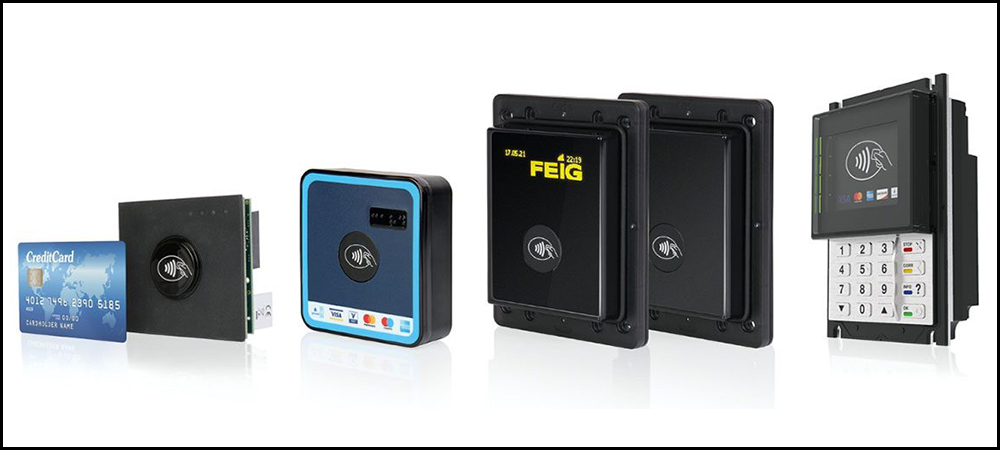Presented here are recent news announcements regarding the following organizations: P360, Swittons, SensThys, FEIG Electronic, Helium, Digital Matter, the Digital Twin Consortium, CESMII, the AIoT User Group and MicroAI.
P360 Adds RFID to Swittons IoT Smart Devices
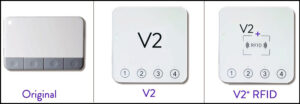 P360, a developer of enterprise software solutions, has introduced the V2 line of its Swittons IoT-enabled smart devices that allow hardware and remote customization capability, as well as optional RFID functionality. The enterprise solution, the company reports, is designed to extend remote ecosystems, provide automation and enhance controls by enabling human-to-digital workflows. The V2 model features a flat, integrated pressure-sensitive button system that enables full-face branding. The V2+ model contains an optional RFID feature to authenticate and streamline key processes within service ecosystems, supply chains, customer communication, manufacturing, inventory controls, emergency response and more.
P360, a developer of enterprise software solutions, has introduced the V2 line of its Swittons IoT-enabled smart devices that allow hardware and remote customization capability, as well as optional RFID functionality. The enterprise solution, the company reports, is designed to extend remote ecosystems, provide automation and enhance controls by enabling human-to-digital workflows. The V2 model features a flat, integrated pressure-sensitive button system that enables full-face branding. The V2+ model contains an optional RFID feature to authenticate and streamline key processes within service ecosystems, supply chains, customer communication, manufacturing, inventory controls, emergency response and more.
“The new Swittons V2 and V2+ models round out our multimodal, multifunctional IoT platform that delivers efficiencies and automations to key enterprise workflows,” said Anupam Nandwana, P360’s CEO and founder, in a prepared statement. “Coupled with Microsoft Azure foundational software elements, which provide seamless integrations across various systems, the new Swittons packages provide advanced enterprise solutions for companies with multiplexed needs.” The platform can be utilized across several functions within the same organization and can be custom-programmed for workstream-specific uses.
The V2+ with RFID can authenticate and track assets within manufacturing, supply chains, laboratories, and sales and service operations. The solutions can be used in the pharmaceutical industry to streamline remote physician engagement, lab operations and clinical trials, by automating frequent requests and triggering communication channels, and the new functionality enables omnichannel, multimodal enterprise applications. Additional use cases include asset tracking, communication, supply chain management, inventory control, remote patient engagement and adherence, and remote clinical trials.
“All of these seemingly independent use cases are actually able to integrate with organization-wide analytics and AI [artificial intelligence], helping to assimilate relevant data to the C-suite,” added Kimberly Brue, P360’s VP of commercial excellence, in the statement. “This enables a true human-to-digital connection within existing enterprise software solutions. Swittons are extremely versatile in that regard, and are only limited by one’s imagination.”
SensThys Intros New RFID Reader
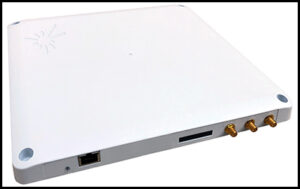 SensThys has announced the fourth generation of its SensArray Core, an EPIC-native RFID reader incorporating an internal 8.5dBic antenna, three additional antenna ports (allowing four antenna systems in total) and a 4-in/4-out 30-watt, optically isolated GPIO subsystem. According to the company, these features are combined in a 10-inch by 10-inch form factor for use in doctors’ offices, warehouses and other environments in which minimizing object protrusion is important.
SensThys has announced the fourth generation of its SensArray Core, an EPIC-native RFID reader incorporating an internal 8.5dBic antenna, three additional antenna ports (allowing four antenna systems in total) and a 4-in/4-out 30-watt, optically isolated GPIO subsystem. According to the company, these features are combined in a 10-inch by 10-inch form factor for use in doctors’ offices, warehouses and other environments in which minimizing object protrusion is important.
The SensArray Enterprise operates at a maximum of 33dBm via a 30- or 90-watt PoE+ input, with no separate DC power input required. The reader is supplied as a flat or through-hole mount, the company reports, with a separate VESA 100-millimeter studded bracket available that allows for mounting to a standard VESA mount. Variants for international regions are also available.
EPIC tags are natively decoded by the reader, according to SensThys, and the device supports Level 2 and Level 4 EPIC decoding. The company says the system is designed to fix data corrupted in the tags’ memory and during transmission, eliminating the problem of bad tag data, as well as phantom or ghost tags.
FEIG Electronic Offers NFC Transit Ticketing Payment System
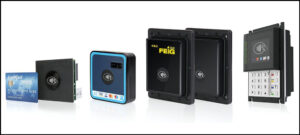 FEIG Electronic is offering its cVEND payment terminal system, its latest such solution for the U.S. transit market. “FEIG specializes in self-service payment terminals to simplify and accelerate payment processes,” said Eric W. Pitts, FEIG Electronic’s senior manager for payments, in a prepared statement. “The cVEND series ensures secure payment transactions in validators and onboard solutions for buses and trains, just as effectively as for ticket vending machines and access gates and systems.”
FEIG Electronic is offering its cVEND payment terminal system, its latest such solution for the U.S. transit market. “FEIG specializes in self-service payment terminals to simplify and accelerate payment processes,” said Eric W. Pitts, FEIG Electronic’s senior manager for payments, in a prepared statement. “The cVEND series ensures secure payment transactions in validators and onboard solutions for buses and trains, just as effectively as for ticket vending machines and access gates and systems.”
The platform enables secure transit payment transactions for open-loop credit or debit cards and closed-loop public transport ticketing systems, the company reports, and is capable of simultaneously reading customer cards, e-tickets and payment cards, so that the cards can be processed quickly and reliably. The payment terminals differ in design and interfaces but are based on a uniform platform that complies with the PCI and EMVCo security and certification standards, utilizing a Linux operating system. The payment terminals include the cVEND plug, the cVEND box, the cVEND box+ and the cVEND PIN, all available globally in various form-factors and configurations.
The devices are being used for transit-ticketing applications worldwide, the company reports. They can read e-tickets or check passengers in via contactless pay-as-you-go scenarios, and they can be installed in locations convenient for customers. The cVEND plug modules read e-tickets or contactless credit or debit cards from all global schemes, showing only the contactless symbol outside the scanner, while the cVEND PIN offers a PIN pad and an optional secure hybrid card reader (chip or magstripe).
The terminals are suitable for turnstiles and gates, the company notes, even during peak times. Utilizing the cVEND TCA, public transport operators can communicate with closed-loop cards using their own application that operates independently from the payment application in a dedicated application slot. Tokenization protects sensitive data by generating a token to act as the identifier during a transit transaction, and an operator can use the token to bill a card via an ABT back-end system. The transaction record is encrypted, changing algorithms for each transaction.
Helium, Digital Matter Release IoT Asset-Tracking Report
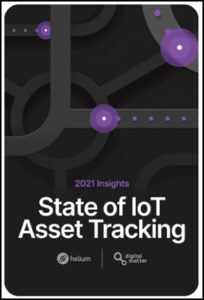 Helium and Digital Matter have announced their 2021 “State of IoT Asset Tracking” report, which provides a snapshot of the commercial and private IoT asset-tracking landscape. Now in its third year, the report compiles findings from a global survey of approximately 2,600 IoT decision-makers and analyzes asset-tracking demands, adoption rates, connectivity and hardware choices, barriers to entry, and more. Respondents included business decision-makers (owners, founders and CEOs) and IT/technical decision-makers (VPs and above, as well as directors and senior executives) from a range of industries, such as hardware and software, healthcare, transport and distribution, retail, agriculture and agribusiness.
Helium and Digital Matter have announced their 2021 “State of IoT Asset Tracking” report, which provides a snapshot of the commercial and private IoT asset-tracking landscape. Now in its third year, the report compiles findings from a global survey of approximately 2,600 IoT decision-makers and analyzes asset-tracking demands, adoption rates, connectivity and hardware choices, barriers to entry, and more. Respondents included business decision-makers (owners, founders and CEOs) and IT/technical decision-makers (VPs and above, as well as directors and senior executives) from a range of industries, such as hardware and software, healthcare, transport and distribution, retail, agriculture and agribusiness.
The report indicates 40 percent of respondents are actively tracking their assets, with vehicles, onsite equipment and personal property cited as the top three assets tracked. Preventing asset loss and theft, followed by enhancing operational efficiency, are the highest drivers of adoption, according to the research. Of the respondents actively tracking their assets, 29 percent continue to leverage legacy 2G and 3G cellular connectivity for their asset-tracking requirements, despite impending network shutdowns in the United States, Australia and parts of Europe.
Approximately 23 percent of respondents are currently using Wi-Fi positioning for asset tracking, while 17 percent are currently using LPWAN networks such as Helium, LoRaWAN, Sigfox, and cellular LTE-M or NB-IoT. “The growing urgency for asset-tracking solutions has resulted in over four times the number of survey respondents compared to 2020,” said Jacob Swinn, Helium’s product marketing manager, in a prepared statement. “With three years’ worth of data, we are now able to identify trends in the asset-tracking market, and what we’re seeing is asset-tracking demand remains high, yet legacy connectivity technologies continue to be costly and complex.”
“As new business cases emerge for the IoT as device and connectivity costs continue to decrease, businesses are able to broaden the range of assets they track,” added Ken Everett, Digital Matter’s CEO and founder, in the prepared statement. “With Helium, we have a reliable and secure, out-of-the-box connectivity solution that businesses can deploy quickly and easily, substantially accelerating time to market.”
Digital Twin Consortium Partners with CESMII, AIoT User Group
The Digital Twin Consortium and CESMII—The Smart Manufacturing Institute have entered into a liaison agreement to influence the creation and development of digital twin-enabling frameworks and technologies. The goal, according to the organizations, is to accelerate the adoption and effective use of digital twins to create value. Digital twins are disrupting product lifecycle management from design to manufacturing, service and operations, the partners report, allowing companies to predict the future instead of analyzing the past.
The two organizations have agreed to the following: collaborating on standardization requirements; realizing interoperability by aligning technology components and other elements; aligning work in horizontal domains for adoption in vertical domains, use cases and proofs-of-concept; various value innovation platform programs; case study development from initial concept through implementation and operational analysis; and collaboration on open-source projects, contributions and reference implementations.
“Manufacturing corporations can leverage digital twins for reduced downtime and increased performance, among other benefits,” said Dan Isaacs, the Digital Twin Consortium’s CTO, in a prepared statement. “We’re excited about our liaison with CESMII, and our efforts to accelerate the use of digital twins in manufacturing.” John Dyck, CESMII’s CEO, added in the statement: “CESMII is excited to engage with the Digital Twin Consortium. Our member organizations and the market more broadly are looking for a more holistic scope, definition and use of digital twins, including a more integrated information framework that spans process design, manufacturing, and maintenance.”
The Consortium has also entered into a liaison agreement with the AIoT User Group to create and develop digital twin-enabling technologies, with the goal of accelerating adoption and monetization. The partners have agreed to the following: aligning work in the Consortium’s horizontal domains for adoption within vertical environments, use cases, proofs-of-concept and programs; making AI and IoT best practices available for practitioners through frameworks and trainings; creating open-source reference implementations and solution blueprints; realizing interoperability by harmonizing technology components and other elements; and collaborating on standards.
“We are excited about our collaboration with the AIoT User Group,” Isaacs said in a separate prepared statement. “AI and IoT are key enabling technologies for digital twins. AIoT User Group’s network of AI and IoT practitioners, good practices, and framework for smart, connected products will be key as we work together to advance the use of digital twins.” Dirk Slama, the AIoT User Group’s chairman, added: “Digital twins are the key design paradigm for any company dealing with the digitalization of physical products or equipment. AI and IoT are fundamental both in creating as well as utilizing digital twins. Being able to build on Digital Twin Consortium’s strong digital twin foundation and partner network make them the perfect liaison for us.”
MicroAI Solution Accelerates Smart System Development
MicroAI, a provider of edge-native artificial intelligence (AI) and machine learning (ML) products, has announced MicroAI Launchpad. The quick-start tool is designed to help organizations simplify and accelerate the design, development, testing and deployment of smart systems that run embedded MicroAI software on microcontrollers and microprocessors in edge and endpoint devices.
Launchpad allows users to handle customers with SIMs around the world, the company explains, while offering a flexible method for managing and reconfiguring device profiles. The tool provides a single pane of glass for customizable dashboards, including account creation, authentication, mobile SIM or LoRaWAN connectivity activation, credit card billing for global SIM connectivity, and onboarding of MicroAI’s embedded software libraries.
“MicroAI’s goal is to democratize the development of smart machines for all organizations across any industry,” said Yasser Khan, MicroAI’s CEO, in a prepared statement. “Regardless of industry or product, building a next-generation smart device includes creating an edge AI model, but also integrating connectivity and cloud resources, as well as device activation and management.” MicroAI’s embedded software, AtomML, enables OEMs to deploy personalized, edge-native AI models, without needing to first develop static edge-AI models in a cloud or laptop environment and then port them to the embedded device. Instead, the company explains, AtomML moves the training and inferencing to the embedded device.
Launchpad, which can be white-labeled, is being used by semiconductor companies, original equipment manufacturers and IoT service providers, MicroAI reports. Semiconductor firms that offer stock-keeping units with MicroAI’s embedded AI software can leverage its device management to help customers expedite design, development, testing and deployment. OEMs directly engaged with MicroAI can utilize Launchpad to evaluate hardware, software and cloud solutions before finalizing deployment models. For service providers, Launchpad is intended to offer a one-stop shop for device certification, connectivity and deployment.

